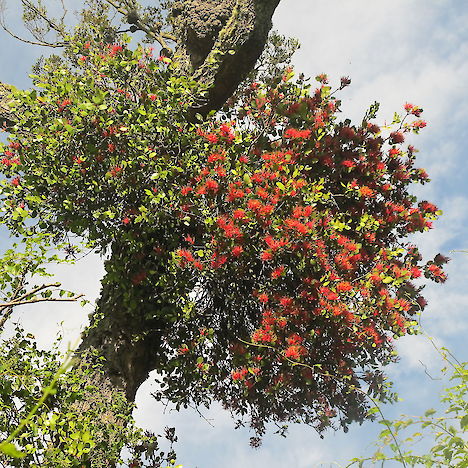Other names:
korukoruThreat category:
At Risk: Declining?Regions:
Northland, Auckland, Waikato, Bay of Plenty, Gisborne, Hawkes Bay, Manawatu-Wanganui, Taranaki, Wellington, Nelson-Tasman, Marlborough, Westcoast, Canterbury, Otago, SouthlandDistribution:
North Island and South Island
Key Features
- Shrubby parasitic plant up to 3 m across, with broad, leathery leaves arranged oppositely and 3-8 cm long.
- The scarlet flowers are linear and arranged in groups of up to five. They often form a conspicuous ground litter after fruiting.
- The small egg-shaped fleshy fruits are yellow in colour.
- Scarlet mistletoe tends to parasitise silver beech (Lophozonia menziesii), but has also been found on Metrosideros (rata) and Pittosporum (lemonwood, kohuhu) and some exotic trees, and is most noticeable, and attractive, when in flower.
Distribution and Habitat
- North and South Islands, from Mt Te Aroha to Southland.
- Mostly at lower altitudes (up to 500 m).
Threats
- Possum browse.
- Habitat modification and loss.
- Decline of birds (chiefly bellbird and tui) associated with pollination and dispersal.
- Fungal disease.
Management Opportunities
- Survey for new locations.
- Mark known sites.
- Protection of habitat.
- Enhance habitat for bellbirds and tui (e.g. by planting nectar-producing species such as flax and kowhai).
- Possum control by poisoning or trapping, or by caging plants or banding host trees.
- Ensure that forest owners are aware of potential habitats and can recognise the species.
Monitoring Options
- Check existing populations annually.
- Report new locations to DOC, NZPCN.
Further Information and Support
- New Zealand Plant Conservation Network (NZPCN). http://www.nzpcn.org.nz
- References
- Dopson et al. (1999). The conservation requirements of New Zealand’s nationally threatened vascular plants. Threatened Species Occasional Publication 13. Department of Conservation, Wellington.
- Poole & Adams (1994). Trees and shrubs of New Zealand. Maanaki Whenua Press, Lincoln.



